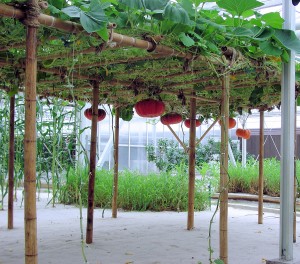 By Melissa Stewart
By Melissa Stewart
As a young horticulturalist, fresh out of college, I remember my first encounter with hydroponic production. This was a topic we didn’t cover in the pages of our textbooks but rather a unique twist to the traditional idea of container culture that I had become accustomed to through years of schooling. As I got my feet wet as a greenhouse grower for one of the largest greenhouses in West Virginia, I was quickly exposed to this method of agricultural production and told that if I could learn to grow hydroponically, I could grow anything. These were words to live by.
For more than a decade, research efforts at West Virginia State University’s (WVSU) Agricultural and Environmental Research Station have focused on the emerging field of hydroponic production, especially its use in tomato breeding and studying disease-resistance in crops. With the increasing availability of hydroponic systems online, the development of educational workshops by the WVSU Extension Service has gained momentum.
What exactly is hydroponic production and what are its benefits? Simply put, hydroponic production is the process of growing plants with nutrients in water.
There are numerous benefits to this type of production method. In traditional agriculture, soil is utilized as the growing medium and within the soil the plants compete with microorganisms for nutrients. These nutrients may also become bound to the soil particles, making it increasingly difficult to ensure that the fertilizer applied is available for uptake by the plants. With hydroponic production, the nutrient solution provides all of the nutrition the plant requires. The grower can make changes in the nutrition according to what the plant is illustrating that it needs, and the plant is able to uptake these nutrients and respond quickly.
Less Disease
Another benefit of soilless means is a decrease in soilbourne insect and disease problems, allowing for cleaner cultivation of crops and less use of pesticides throughout the growing cycle. A high-quality, clean crop demands a higher price in the local marketplace, making this an intriguing method of production for many small farmers in our state.
Weeds, Be Gone
By growing hydroponically, weeds become a thing of the past. Weed seeds traditionally harbor in the soil and wait until conditions are right for them to germinate. Since the hydroponic media utilized is sterile and void of contact with any weed materials, weeds are not a concern. Agricultural production in lieu of weeds seems futuristic in nature, especially when presented to older farmers who have become used to the ongoing battle between crop production and weed control. Taking this technology to a small farming operation could greatly reduce the time spent on crop maintenance, not to mention the relief provided to the farmer.
Variety, the Spice of Life
There are many hydroponic production systems on the market, but all have the same purpose of convenient crop cultivation. Gardening in the traditional sense can be labor-intensive when it comes to planting and maintenance. Depending on the system utilized, hydroponic planting can be as easy as dropping a seedling into a growing port in a channel. These systems rely on stock tanks of nutrient solution that is circulated through the growing system at a continuous rate or controlled by a timer. After the systems are set up, they practically run themselves, requiring only daily monitoring to ensure proper working order. In most instances, the systems and techniques are easy to learn and repetitious in nature.
Education Programs
With this in mind, these systems have been a perfect overlap with current agricultural education programs. At the elementary age, in conjunction with the Junior Master Gardener program, kids are being introduced to vertical hydroponic production systems in both greenhouse and outdoor scenarios. At the middle and high school level, hydroponic production has been integrated into many Future Farmers of America chapters’ greenhouse production and is being targeted as a method of production for Farm 2 School efforts.
Water Conservation
Due to the use of stock solutions and recirculating systems, water conservation is another benefit of hydroponics. In conventional agriculture, fields are irrigated on a regular basis to ensure that the crops are receiving sufficient water during peak times of production. In drought conditions, it becomes more difficult for the farmer to meet watering needs. In a hydroponic system with a crop such as lettuce, the same stock tank of nutrient solution can be utilized throughout the 6-8 week growing cycle with few additions. Working from a 20-gallon reservoir tank, growing between 20-28 plants per vertical tower, the water conservation potential is amazing.
Less Contamination
This production methodology also provides a solution to agricultural production concerns in areas with soil and water contamination problems. Hydroponics utilizes nutrient solutions at lower concentrations since the nutrients are readily available for absorption by the plant. This combats the problem of nutrient-loading in the soil, a concern in traditional agriculture, resulting in eutrophication of local streams and waterways. When the stock tanks are ready to be remixed, the depleted fertilizer solution can be used on other plant material.
Increased Productivity
Since plants are receiving everything they need when they need it, these systems tend to be more productive. The resulting higher yields in shortened time frames allow the grower to better accommodate the local markets while demanding a higher price for the produce. There are several vertical hydroponic systems on the market that allow for more plants to be grown in less space. In greenhouse production, the best utilization of space is imperative to keep heating and cooling costs to a minimum. Growing vertically uses the dead air space in a greenhouse, while allowing for a less labor-intensive harvest.
Less Pain
One of the main concerns in agricultural production is back pain. A report out of the Ag Center at University of California, Davis, states that back pain among individuals working in agriculture is about 1.5 times higher than the average for all U.S. industries. Harvesting crops produced in vertical units allows the worker to harvest mainly in a standing or reaching position rather than stooping, resulting in less overall back strain. This has also made vertical production viable in the realm of adaptive gardening. These systems have made gardening enjoyable again for individuals suffering from arthritis or osteoporosis.
Added Value
Finally, hydroponic production can be a value-added product to a traditional farming practice. With a push toward niche markets, a small hydroponic venture could bring in additional money to a farming operation after the cash crops have finished production. There are many alternative crops that can be produced in these systems, from herbs to small fruits, which can supply local restaurants or other markets while keeping the money in our local economy.
With the demand for local foods exploding, the response to these systems and the desire to learn how to produce in them has been overwhelming. With collaborations on the horizon, it is conceivable that, in the near future, the fruits and vegetables you are consuming at a local restaurant may have been grown and harvested from the establishment’s rooftop that very morning. You can’t get more local than that!
About the Author
 A West Virginia native, Melissa Stewart was a 1991 graduate of Ravenswood High School and continued her education at West Virginia University, where she earned bachelor’s degrees in horticulture and environmental protection. After college she continued to pursue her love of horticulture as the head grower for Gritt’s Midway Greenhouse from 1997-2002. She accepted a position at West Virginia State College in 2002 to manage the Research Greenhouses and worked directly with Dr. Barbara Liedl on hydroponic research in conjunction with the Bioplex Projection campus. In 2004, she switched roles to become the Agriculture and Natural Resources Extension agent for West Virginia State University, and she also took on the role of state coordinator for the Junior Master Gardener Program in West Virginia. During this timeframe she went on to pursue a master’s degree in environmental science at Marshall University, which she earned in 2009. Currently, Stewart serves as the Agriculture and Natural Resources specialist at West Virginia State University Extension Service with specialization in hydroponic/aeroponic production, community and adaptive gardening, youth gardening, sustainable agriculture and environmental topics.
A West Virginia native, Melissa Stewart was a 1991 graduate of Ravenswood High School and continued her education at West Virginia University, where she earned bachelor’s degrees in horticulture and environmental protection. After college she continued to pursue her love of horticulture as the head grower for Gritt’s Midway Greenhouse from 1997-2002. She accepted a position at West Virginia State College in 2002 to manage the Research Greenhouses and worked directly with Dr. Barbara Liedl on hydroponic research in conjunction with the Bioplex Projection campus. In 2004, she switched roles to become the Agriculture and Natural Resources Extension agent for West Virginia State University, and she also took on the role of state coordinator for the Junior Master Gardener Program in West Virginia. During this timeframe she went on to pursue a master’s degree in environmental science at Marshall University, which she earned in 2009. Currently, Stewart serves as the Agriculture and Natural Resources specialist at West Virginia State University Extension Service with specialization in hydroponic/aeroponic production, community and adaptive gardening, youth gardening, sustainable agriculture and environmental topics.




1 Comment
Melissa,
I am in the process of establishing a hydroponic farm in Fayette County. What can you tell me about the State of West Virginia Department of Agriculture in terms of the Farm to Table program?